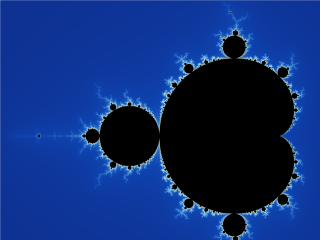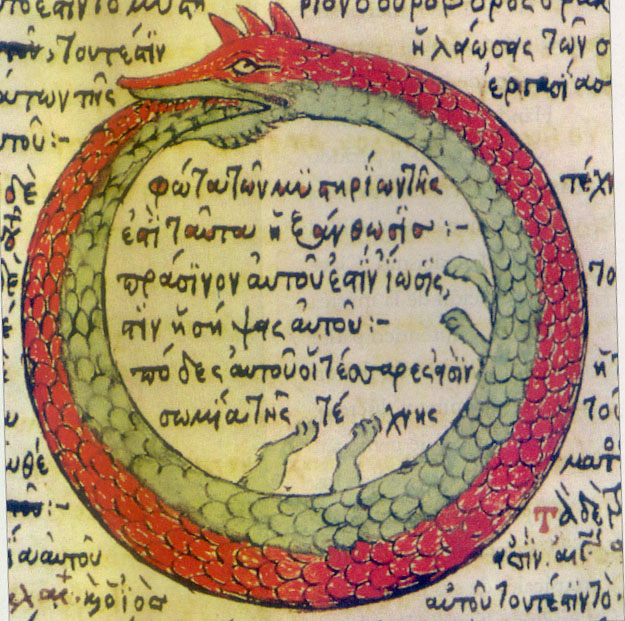|
Fractals
In mathematics, a fractal is a Shape, geometric shape containing detailed structure at arbitrarily small scales, usually having a fractal dimension strictly exceeding the topological dimension. Many fractals appear similar at various scales, as illustrated in successive magnifications of the Mandelbrot set. This exhibition of similar patterns at increasingly smaller scales is called self-similarity, also known as expanding symmetry or unfolding symmetry; if this replication is exactly the same at every scale, as in the Menger sponge, the shape is called affine geometry, affine self-similar. Fractal geometry lies within the mathematical branch of measure theory. One way that fractals are different from finite geometric figures is how they Scaling (geometry), scale. Doubling the edge lengths of a filled polygon multiplies its area by four, which is two (the ratio of the new to the old side length) raised to the power of two (the conventional dimension of the filled polygon). ... [...More Info...] [...Related Items...] OR: [Wikipedia] [Google] [Baidu] |
Mandelbrot Set
The Mandelbrot set () is a two-dimensional set (mathematics), set that is defined in the complex plane as the complex numbers c for which the function f_c(z)=z^2+c does not Stability theory, diverge to infinity when Iteration, iterated starting at z=0, i.e., for which the sequence f_c(0), f_c(f_c(0)), etc., remains bounded in absolute value. This set was first defined and drawn by Robert W. Brooks and Peter Matelski in 1978, as part of a study of Kleinian groups. Afterwards, in 1980, Benoit Mandelbrot obtained high-quality visualizations of the set while working at IBM's Thomas J. Watson Research Center in Yorktown Heights, New York. Images of the Mandelbrot set exhibit an infinitely complicated Boundary (topology), boundary that reveals progressively ever-finer Recursion, recursive detail at increasing magnifications; mathematically, the boundary of the Mandelbrot set is a ''fractal curve''. The "style" of this recursive detail depends on the region of the set boundary being ... [...More Info...] [...Related Items...] OR: [Wikipedia] [Google] [Baidu] |
Fractal Dimension
In mathematics, a fractal dimension is a term invoked in the science of geometry to provide a rational statistical index of complexity detail in a pattern. A fractal pattern changes with the Scaling (geometry), scale at which it is measured. It is also a measure of the Space-filling curve, space-filling capacity of a pattern and tells how a fractal scales differently, in a fractal (non-integer) dimension. The main idea of "fractured" Hausdorff dimension, dimensions has a long history in mathematics, but the term itself was brought to the fore by Benoit Mandelbrot based on How Long Is the Coast of Britain? Statistical Self-Similarity and Fractional Dimension, his 1967 paper on self-similarity in which he discussed ''fractional dimensions''. In that paper, Mandelbrot cited previous work by Lewis Fry Richardson describing the counter-intuitive notion that a coastline's measured length changes with the length of the measuring stick used (see #coastline, Fig. 1). In terms of that ... [...More Info...] [...Related Items...] OR: [Wikipedia] [Google] [Baidu] |
Hausdorff Dimension
In mathematics, Hausdorff dimension is a measure of ''roughness'', or more specifically, fractal dimension, that was introduced in 1918 by mathematician Felix Hausdorff. For instance, the Hausdorff dimension of a single point is zero, of a line segment is 1, of a square is 2, and of a cube is 3. That is, for sets of points that define a smooth shape or a shape that has a small number of corners—the shapes of traditional geometry and science—the Hausdorff dimension is an integer agreeing with the usual sense of dimension, also known as the topological dimension. However, formulas have also been developed that allow calculation of the dimension of other less simple objects, where, solely on the basis of their properties of scaling and self-similarity, one is led to the conclusion that particular objects—including fractals—have non-integer Hausdorff dimensions. Because of the significant technical advances made by Abram Samoilovitch Besicovitch allowing computation of di ... [...More Info...] [...Related Items...] OR: [Wikipedia] [Google] [Baidu] |
Menger Sponge
In mathematics, the Menger sponge (also known as the Menger cube, Menger universal curve, Sierpinski cube, or Sierpinski sponge) is a fractal curve. It is a three-dimensional generalization of the one-dimensional Cantor set and two-dimensional Sierpinski carpet. It was first described by Karl Menger in 1926, in his studies of the concept of topological dimension. Construction The construction of a Menger sponge can be described as follows: # Begin with a cube. # Divide every face of the cube into nine squares in a similar manner to a Rubik's Cube. This sub-divides the cube into 27 smaller cubes. # Remove the smaller cube in the middle of each face and remove the smaller cube in the center of the larger cube, leaving 20 smaller cubes. This is a level 1 Menger sponge (resembling a void cube). # Repeat steps two and three for each of the remaining smaller cubes and continue to iterate ''ad infinitum''. The second iteration gives a level 2 sponge, the third iteration gives a level 3 s ... [...More Info...] [...Related Items...] OR: [Wikipedia] [Google] [Baidu] |
Self-similarity
In mathematics, a self-similar object is exactly or approximately similar to a part of itself (i.e., the whole has the same shape as one or more of the parts). Many objects in the real world, such as coastlines, are statistically self-similar: parts of them show the same statistical properties at many scales. Self-similarity is a typical property of fractals. Scale invariance is an exact form of self-similarity where at any magnification there is a smaller piece of the object that is similar to the whole. For instance, a side of the Koch snowflake is both symmetrical and scale-invariant; it can be continually magnified 3x without changing shape. The non-trivial similarity evident in fractals is distinguished by their fine structure, or detail on arbitrarily small scales. As a counterexample, whereas any portion of a straight line may resemble the whole, further detail is not revealed. Peitgen ''et al.'' explain the concept as such: Since mathematically, a fractal may sho ... [...More Info...] [...Related Items...] OR: [Wikipedia] [Google] [Baidu] |
Fractal Curve
A fractal curve is, loosely, a mathematical curve (mathematics), curve whose shape retains the same general pattern of Pathological (mathematics), irregularity, regardless of how high it is magnified, that is, its graph takes the form of a fractal. In general, fractal curves are nowhere rectifiable curves — that is, they do not have finite Curve length, length — and every subarc longer than a single Point (geometry), point has infinite length. A famous example is the boundary of the Mandelbrot set. Fractal curves in nature Fractal curves and fractal patterns are widespread, in nature, found in such places as broccoli, snowflakes, feet of geckos, frost crystals, and Lightning strike, lightning bolts. See also Romanesco broccoli, dendrite (crystal), dendrite crystal, Patterns_in_nature#Trees,_fractals, trees, fractals, Hofstadter's butterfly, Lichtenberg figure, and self-organized criticality. Dimensions of a fractal curve Most of us are used to mathematical curves having ... [...More Info...] [...Related Items...] OR: [Wikipedia] [Google] [Baidu] |
Mathematics
Mathematics is a field of study that discovers and organizes methods, Mathematical theory, theories and theorems that are developed and Mathematical proof, proved for the needs of empirical sciences and mathematics itself. There are many areas of mathematics, which include number theory (the study of numbers), algebra (the study of formulas and related structures), geometry (the study of shapes and spaces that contain them), Mathematical analysis, analysis (the study of continuous changes), and set theory (presently used as a foundation for all mathematics). Mathematics involves the description and manipulation of mathematical object, abstract objects that consist of either abstraction (mathematics), abstractions from nature orin modern mathematicspurely abstract entities that are stipulated to have certain properties, called axioms. Mathematics uses pure reason to proof (mathematics), prove properties of objects, a ''proof'' consisting of a succession of applications of in ... [...More Info...] [...Related Items...] OR: [Wikipedia] [Google] [Baidu] |
Topological Dimension
In mathematics, the Lebesgue covering dimension or topological dimension of a topological space is one of several different ways of defining the dimension of the space in a topologically invariant way. Informal discussion For ordinary Euclidean spaces, the Lebesgue covering dimension is just the ordinary Euclidean dimension: zero for points, one for lines, two for planes, and so on. However, not all topological spaces have this kind of "obvious" dimension, and so a precise definition is needed in such cases. The definition proceeds by examining what happens when the space is covered by open sets. In general, a topological space ''X'' can be covered by open sets, in that one can find a collection of open sets such that ''X'' lies inside of their union. The covering dimension is the smallest number ''n'' such that for every cover, there is a refinement in which every point in ''X'' lies in the intersection of no more than ''n'' + 1 covering sets. This is the gist o ... [...More Info...] [...Related Items...] OR: [Wikipedia] [Google] [Baidu] |
Recursion
Recursion occurs when the definition of a concept or process depends on a simpler or previous version of itself. Recursion is used in a variety of disciplines ranging from linguistics to logic. The most common application of recursion is in mathematics and computer science, where a function (mathematics), function being defined is applied within its own definition. While this apparently defines an infinite number of instances (function values), it is often done in such a way that no infinite loop or infinite chain of references can occur. A process that exhibits recursion is ''recursive''. Video feedback displays recursive images, as does an infinity mirror. Formal definitions In mathematics and computer science, a class of objects or methods exhibits recursive behavior when it can be defined by two properties: * A simple ''base case'' (or cases) — a terminating scenario that does not use recursion to produce an answer * A ''recursive step'' — a set of rules that reduce ... [...More Info...] [...Related Items...] OR: [Wikipedia] [Google] [Baidu] |
Iteration
Iteration is the repetition of a process in order to generate a (possibly unbounded) sequence of outcomes. Each repetition of the process is a single iteration, and the outcome of each iteration is then the starting point of the next iteration. In mathematics and computer science, iteration (along with the related technique of recursion) is a standard element of algorithms. Mathematics In mathematics, iteration may refer to the process of iterated function, iterating a function, i.e. applying a function repeatedly, using the output from one iteration as the input to the next. Iteration of apparently simple functions can produce complex behaviors and difficult problems – for examples, see the Collatz conjecture and juggler sequences. Another use of iteration in mathematics is in iterative methods which are used to produce approximate numerical solutions to certain mathematical problems. Newton's method is an example of an iterative method. Manual calculation of a number's sq ... [...More Info...] [...Related Items...] OR: [Wikipedia] [Google] [Baidu] |
Bernhard Riemann
Georg Friedrich Bernhard Riemann (; ; 17September 182620July 1866) was a German mathematician who made profound contributions to analysis, number theory, and differential geometry. In the field of real analysis, he is mostly known for the first rigorous formulation of the integral, the Riemann integral, and his work on Fourier series. His contributions to complex analysis include most notably the introduction of Riemann surfaces, breaking new ground in a natural, geometric treatment of complex analysis. His 1859 paper on the prime-counting function, containing the original statement of the Riemann hypothesis, is regarded as a foundational paper of analytic number theory. Through his pioneering contributions to differential geometry, Riemann laid the foundations of the mathematics of general relativity. He is considered by many to be one of the greatest mathematicians of all time. Early years Riemann was born on 17 September 1826 in Breselenz, a village near Danne ... [...More Info...] [...Related Items...] OR: [Wikipedia] [Google] [Baidu] |









